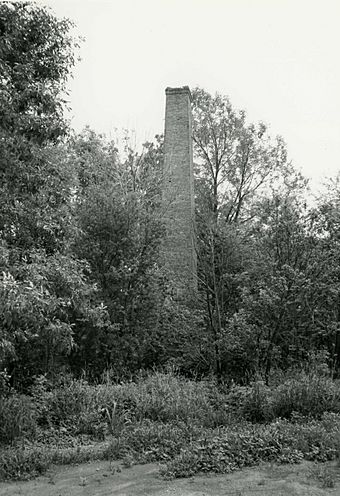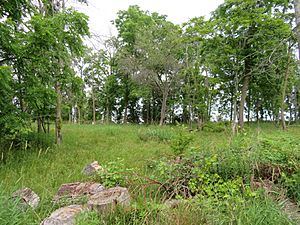W. R. Stafford Planing Mill Site facts for kids
Quick facts for kids |
|
|
W. R. Stafford Planing Mill Site
|
|

W.R. Stafford Planing Mill Site, 1985
|
|
| Location | Huron St., Port Hope, Michigan |
|---|---|
| Area | less than one acre |
| Built | 1882 |
| MPS | Port Hope MPS |
| NRHP reference No. | 87001960 |
| Added to NRHP | November 20, 1987 |
The W. R. Stafford Planing Mill Site was once a busy place where wood was cut and shaped, and doors and windows were made. It was located on Huron Street in Port Hope, Michigan. This important historical site was added to the National Register of Historic Places in 1987.
The Story of the W. R. Stafford Mill
A terrible forest fire happened in 1881. After this fire, a new building was built at this spot. This building became a planing mill around 1882.
A planing mill uses machines to smooth and shape wood. The first floor of this building was the planing mill. On the second floor, Duncan McKenzie and George Drury ran a factory. They made things like window sashes and doors there.
At the end of the 1800s, the lumber business was slowing down. Even so, the planing mill and its factory were big employers in the area. Many people worked there. The mill stopped operating in the mid-1890s.
Later, in 1905, a man named Gustave Marquardt leased the building. He used it as a pea mill. In a pea mill, peas were cleaned and put into sacks. However, in 1912, a disease ruined the local pea crops. Because of this, the pea business also closed down.
Over time, the mill building was taken down. By 1987, only the tall chimney was left standing. But by 2017, even the chimney was gone.
What's Left at the Site Today?
The old planing mill site is now in the woods. It is close to the shore of Lake Huron. If you visit, you can still see the foundations of the old mill. These are the stone or brick bases that the building once sat on. They measure about 80 feet long and 36 feet wide.
There used to be a tall chimney at the site. It was about 50 feet high. The base of the chimney was about six and a half feet by six feet. This chimney was made of red bricks and got narrower as it went up.




